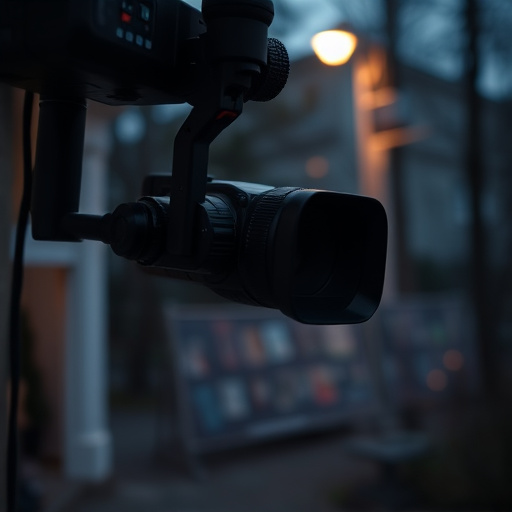Wireless spy cameras with cloud storage pose significant privacy risks. To protect against unauthorized access, users should understand camera operation, audit networks regularly, use detection apps, update software, and enable two-factor authentication for cloud accounts. Advanced detection methods leveraging computer vision and machine learning identify hidden lenses via unique patterns, enhancing safety in both public and private spaces.
In today’s digital age, privacy concerns have escalated with the proliferation of wireless spy cameras. This article delves into the intricacies of detecting these hidden threats, focusing on advanced techniques like cloud storage tracking and mobile phone lens identification. Understanding wireless spy cameras is the first step in navigating this complex landscape. Learn how to recognize them, employ countermeasures, and stay secure in an era where discretion is increasingly elusive.
- Understanding Wireless Spy Cameras
- Tracking Devices via Cloud Storage
- Detecting Lenses on Mobile Phones
- Advanced Camera Identification Techniques
- Preventing and Countering Spy Camera Threats
Understanding Wireless Spy Cameras
Wireless spy cameras have transformed the way we think about security and privacy. These compact, often undetectable devices are connected to the internet, allowing for remote surveillance via a smartphone or computer. One of their most insidious features is their ability to store footage in cloud storage, making it easily accessible from anywhere with an internet connection. This capability raises significant concerns about data privacy and security, as unauthorized individuals could potentially gain access to sensitive information captured by these cameras.
Understanding how wireless spy cameras operate and the extent of their connectivity is crucial for safeguarding against this modern threat. These devices can be hidden in everyday objects like plants, light bulbs, or even clothing, making them difficult to detect. By being aware of potential hidden camera setups and regularly auditing your home or office network for connected devices, you can better protect yourself from surveillance.
Tracking Devices via Cloud Storage
Wireless spy cameras, a growing concern in today’s digital era, often employ cloud storage as a means to track and access hidden devices. This silent surveillance network allows users to monitor activities remotely, making it crucial for individuals to be aware of potential hidden threats. By utilizing cloud-based platforms, these wireless spy cameras can transmit real-time footage and data, enabling easy tracking and identification of suspicious activities.
The integration of cloud storage in spy camera systems offers a level of convenience and accessibility that raises concerns about privacy. As such, it’s essential for users to be vigilant and informed about the potential risks associated with these devices. Staying proactive and adopting measures to protect personal spaces can help mitigate the impact of hidden wireless spy cameras, ensuring a safer digital environment.
Detecting Lenses on Mobile Phones
With the rise of wireless spy cameras, the need for advanced detection methods has become increasingly important. Mobile phones have evolved into powerful tools capable of identifying hidden lenses, thanks to their advanced camera systems and processing capabilities. By utilizing machine learning algorithms and computer vision techniques, modern smartphones can now analyze images and videos in real-time to detect suspicious objects like spy camera lenses.
This technology leverages cloud storage solutions to further enhance its effectiveness. Phone applications can access a vast database of known lens patterns and signatures stored in the cloud, allowing for quick comparisons and accurate identifications. As a result, users can be alerted about potential wiretaps or hidden surveillance devices, ensuring their privacy and peace of mind.
Advanced Camera Identification Techniques
The detection and identification of spy camera lenses in modern times have evolved significantly, driven by advancements in computer vision and machine learning algorithms. One of the primary techniques employed is advanced camera identification, which involves analyzing unique lens patterns, sensor characteristics, and software signatures. By comparing captured images or video feeds with known databases, these systems can pinpoint specific make, model, and even version of the camera. This capability is particularly useful in identifying hidden wireless spy cameras that often employ specialized lenses for covert surveillance.
Cloud storage plays a pivotal role in this process by serving as a centralized repository for image and video data. When an suspicious device is detected, captured footage can be swiftly uploaded to cloud servers, where advanced analytics and pattern recognition algorithms process the content. This enables authorities or individuals to identify hidden cameras and take appropriate action, ensuring privacy and security in both public and private spaces.
Preventing and Countering Spy Camera Threats
Spy cameras, often hidden and disguised, pose a significant threat in today’s digital age. With the widespread use of wireless spy cameras, individuals’ privacy can be invaded through remote surveillance. These tiny devices can be easily concealed in everyday objects, making it challenging to identify and detect them. When connected to cloud storage, spy cameras allow for continuous monitoring without the subject’s knowledge.
To combat this growing concern, users should stay vigilant and take proactive measures. Regularly updating software security patches is essential to fix vulnerabilities that could enable remote access. Utilizing advanced camera detection apps can help identify suspicious lenses on devices or in public spaces. Additionally, enabling a two-factor authentication process for cloud storage accounts adds another layer of protection, ensuring that only authorized individuals can access personal data and preventing unauthorized use of hidden cameras.
Wireless spy cameras pose a significant threat in today’s digital age, with cloud storage enabling covert surveillance. By leveraging advanced camera identification techniques, mobile phone users can now actively detect and counter these devices. Understanding how to track and identify lenses through cloud storage analytics empowers individuals to protect their privacy. Staying informed about spy camera technology and implementing preventive measures is crucial to navigating this modern-day enigma.
